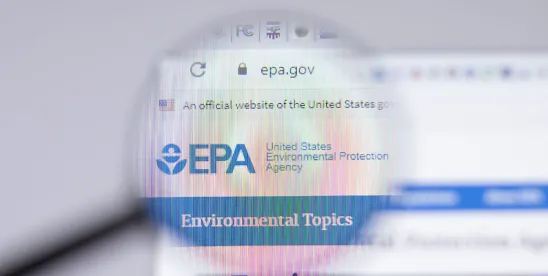On May 2, 2025, U.S. Environmental Protection Agency (EPA) Administrator Lee Zeldin announced the “[n]ext phase of organizational improvements to better integrate science into agency offices.” As part of this reorganization effort, Administrator Zeldin introduced the creation of the Office of Applied Science and Environmental Solutions (OASES) within the Office of the Administrator. According to Zeldin, OASES will “align research and put science at the forefront of the agency’s rulemakings and technical assistance to states.”
That same day, The New York Times published an article titled, “Out at the E.P.A.: Independent Scientists. In: Approving New Chemicals.” The piece suggests that EPA’s renewed focus on addressing the backlog of new chemical submissions under the Toxic Substances Control Act (TSCA) amounts to a policy of automatic approval, an oversimplification that mischaracterizes both TSCA statutory requirements and the Agency’s intended actions.
First enacted in 1976, TSCA grandfathered in all chemicals in commerce at the time (deemed “existing chemicals”). When Congress amended TSCA in 2016 through the bipartisan Frank R. Lautenberg Chemical Safety for the 21st Century Act (Lautenberg), “new TSCA” laid out a detailed chemical prioritization, risk evaluation, and risk management scheme for existing chemicals identified as high-priority. EPA has developed a framework for evaluating these legacy chemicals, and has prioritized and assessed chemicals largely drawn from the 2014 Update to the TSCA Work Plan. To date, EPA has concluded that all existing chemicals it has reviewed present an “unreasonable risk” and has issued final risk management rules for five and proposed risk management rules on an additional three of the first ten chemicals. EPA has imposed restrictions to eliminate unreasonable risk on these chemicals in five final rules, all of which are being judicially challenged. Currently, EPA is in the process of evaluating another 28 chemical substances under Lautenberg. If personnel are transferred into the TSCA assessment program, it does not mean those assessments are likely to receive an “automatic approval” for continued use.
“New” chemicals have always undergone rigorous premanufacture notice review (PMN) by EPA scientists. Before the Lautenberg amendments, EPA developed and often relied upon an assessment regimen that used knowledge, models, and information on analog chemicals as the basis for many assessments of new chemical applications. The 2016 amendments formalized the process and requires that EPA make one of five risk determinations (not likely to present an unreasonable risk, may present an unreasonable risk, may present an unreasonable risk if produced in substantial quantities, that there is insufficient information to make a determination, or that the chemical presents an unreasonable risk). Unless EPA makes a “not likely” finding, EPA must issue a restriction in the form of an order and a Significant New Use Rule (SNUR). In nearly all cases in which EPA identified a hazard other than “low hazard,” EPA has imposed restrictions regardless of their relative hazard or risk vis-a-vis comparable existing chemicals. While the program developed under the original legislation — using knowledge and evaluation based on structurally similar chemicals — was “not good enough” for some detractors, it was no automatic approval process and regulated new chemical risks according to TSCA requirements. The fundamental approval standard of the 1976 or 2016 legislation remains the same — to control unreasonable risk from chemicals — but the new chemical review program since 2016 has been frustrating chemical innovation.
While the majority of existing chemicals can be used without additional scrutiny or reporting obligations, new chemicals with consent orders and/or SNURs are commercially disadvantaged. When a chemical goes through the PMN review process and can be shown to have a favorable toxicological profile compared to currently used chemicals for the same uses/current products, it is disadvantaged in the marketplace even though it has a better risk profile. It will face greater regulatory hurdles and market access challenges due to the issuance of an order or SNUR than a more hazardous, existing chemical that has not yet gone through TSCA risk assessment. Industry stakeholders often refer to this disparity as the “new chemical bias.”
EPA’s recent efforts to prioritize the review of new chemical submissions, long subject to delays and underinvestment, should not be misconstrued as deregulation. Allocation of staff with the right expertise — toxicologists, chemists, industrial hygienists — is an attempt to help with the review of EPA’s backlog of pending cases. There will likely be little change to EPA’s interpretation of what substances are “not likely” to present an unreasonable risk. Finding ways to address delays and backlogs are separate from criticism or debate about what the overall EPA budget should be. EPA should be adequately resourced to both operate a review program for chemicals (and pesticides) and conduct research on environmental issues as part of its overall mission.
For EPA’s new chemical review program, what is needed is a long-overdue step toward regulatory equity. EPA needs either to reconsider its interpretation of Section 5 or Congress needs to act to clarify whether it views EPA’s interpretation as what is best. Consumers and manufacturers alike stand to benefit from a process that allows safer, innovative chemicals to compete on a level regulatory playing field with legacy substances that will not rise to a level that would justify EPA designating the substance as high priority for risk evaluation.




 />i
/>i

